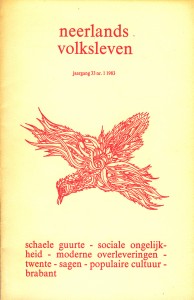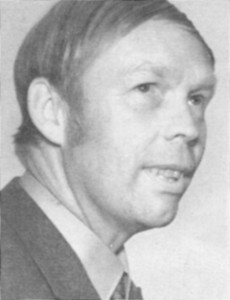Forrays into Folklore
Dutch publications on Dutch `folklore’
 The Dutch anthropologist Jojada Verrips put me on the trail of legends; as an anthropologist working both in and on the Netherlands, he was in touch with the local folklorists. When Tjaard de Haan (the editor of Neerlands volksleven), looked for an author who could put together a volume of `folk tales’ in the province of Utrecht and adjacent Noord-Holland, he asked Jojada and, for some reason, Jojada asked me. Thus it started.
The Dutch anthropologist Jojada Verrips put me on the trail of legends; as an anthropologist working both in and on the Netherlands, he was in touch with the local folklorists. When Tjaard de Haan (the editor of Neerlands volksleven), looked for an author who could put together a volume of `folk tales’ in the province of Utrecht and adjacent Noord-Holland, he asked Jojada and, for some reason, Jojada asked me. Thus it started.
After the volume on Utrecht, I compiled one on Noord-Brabant and after that one on Dutch Limburg. Eventually, I took over as editor of the series, as well as of the last volume of the journal Neerlands volksleven.
As a critical anthropologist, I always had an ambivalent relation to concepts like `folklore’ and even `folk tale’: on the one hand I found their content always extremely enticing, on the other I recognized them as problematic constructs.
– Volksverhalen uit Utrecht en Het Gooi. Utrecht/Antwerpen: Het Spectrum (1979).
– Volksverhalen uit Noord-Brabant. Utrecht/Antwerpen: Het Spectrum (1980).
– Volksverhalen uit Nederlands Limburg. Utrecht/Antwerpen: Het Spectrum (1981).
Already the first volume contained a few witches, from the sixteenth, seventeenth and the twentieth century.
In ‘s-Hertogenbosch, I consulted the collection of J.R.W. Sinninghe and discovered several anomalies.
– De volksverhalen van J.R.W. Sinninghe, Volkskundig bulletin 7 (1981), 162-193.
Summary: The folktales of J.R.W. Sinninghe
J.R.W. Sinninghe is one of the best known and most honoured researchers and collectors of folk-narratives in the Netherlands. Internationally he acquired some fame with his Katakog der niederländischen Märchen-, Ursprungssagen-, Sagen und Legendenvarianten (1943, FFC 132). Reconstruction of his field-work and his activities on the proposad sequel to the Katalog shows that he dropped behind other researchers: the penalty of taking the lead. His collection, now at the library of the `Provinciaal Genootschap van Kunsten en Wetenschappen’ at ‘s-Hertogenbosch, consists mainly (90%) of folk-legends gathered by Belgian students of the Catholic University of Leuven, and even part of the supposed results of his own field-work (2%) has been gathered by other collectors. As he did not make a clear distinction between written and oral texts and hardly paid any attention to the narrators, his collection and publications can not be considered as scientific reports on folk-narration. Newspapermen, and subsequently the general public, have overestimated his work, as well as the international value of the Katalog. Continuation of this situation was possible through the lack of better Dutch researchers and the near absence of folklore at the Dutch universities.
When Tjaard died in 1983, I wrote his obituary and an article about his field work:
– Tjaard Wiebo Renzo de Haan, Jaarboek van de Maatschappij der Nederlandse letterkunde te Leiden 1983-1984 (1985), 122-128.
– Het Groninger veldwerk van Tjaard W.R. de Haan’, Driemaandelijkse bladen 37 (1986) 95-117.
My critical stance towards `folklore’ provoked interest in both its history and in the newer category of `popular culture’, which I consider(ed) as equally problematic:
– Over populaire cultuur, in: De held in het oorlogsmuseum en andere beschouwingen over populaire cultuur. Rotterdam: werkgroep populaire cultuur (1983), 3-28.
– (with Gerrit Jan de Rook) Mensen en dingen: kanttekeningen bij populaire cultuur, Neerlands volksleven 33 (1984), 406-413.
– Notities over het vastleggen van de eigen tijd, Museumvisie 8 (1984), 116-118.
– Wetenschap en popularisatie: de Nederlandse volkskundige tradities over duivekaters en steffenen, Volkscultuur: tijdschrift over tradities en tijdsverschijnselen 2 (1985), 37-70.
After this I concentrated on the Dutch witches (for a while).
– Van sagen naar herinneringen en verhalen, Ethnologia Flandrica 6 (1990), 53-73.
Summary: From Legends to Recollections and Stories
The supernatural or paranormal figures prominently in current definitions of the concept legend. Historically, however, the supernatural can be seen as a substitute for superstition, which was determined by its counterparts belief and enlightenment. The latter were obscured when superstition was reified in the supernatural. As a story about superstition, the legend existed mainly in the mind of the researcher. It is an academic construction. Legends also form a specific selection of an informant’s repertoire. It seems appropriate to exchange legend for recollection and stories, as these prove closer to indigenous categories. The study of legend can dissolve in the study of, for instance, illness, health and sexuality, of conflict and liminality, of the proxemics and kinesics of daily life.
